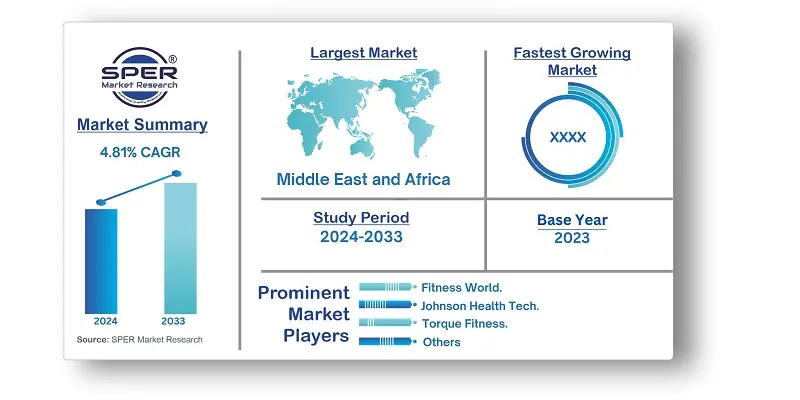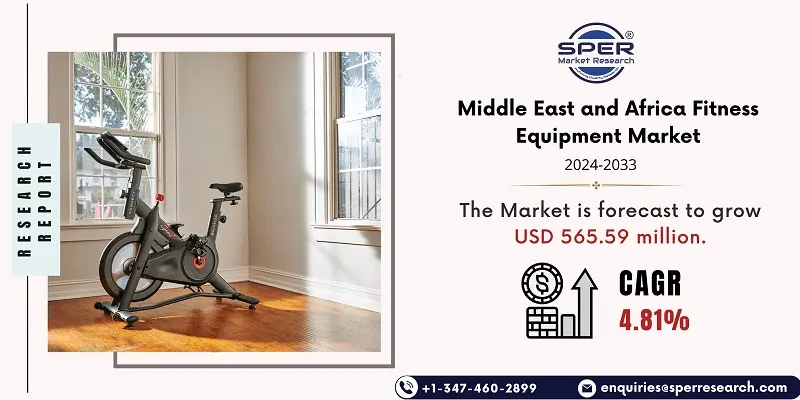
MEA Fitness Equipment Market Growth, Size, Trends, Demand, Share, Revenue and Future Outlook
Middle East and Africa Fitness Equipment Market Size- By Product Type, By Application, By Gender, By Buyer Type- Regional Outlook, Competitive Strategies and Segment Forecast to 2033
| Published: Jun-2024 | Report ID: MACH2426 | Pages: 1 - 152 | Formats*: |
| Category : Equipment and Machinery | |||
- March 2023; In order to grow throughout the GCC, Core Health & workout teamed up with CRANK, a specialized workout studio in the United Arab Emirates. The RIDE program at CRANK will feature indoor bikes from Core Health & Fitness, improving the workout environment within the studio.
- June 2022; Johnson Health Tech created a wholly-owned subsidiary in India by purchasing Cravatex Brands Limited's fitness segment. By investing in manufacturing know-how and product development, Johnson Health Tech grew its company and improved the fitness sector.


| Report Metric | Details |
| Market size available for years | 2020-2033 |
| Base year considered | 2023 |
| Forecast period | 2024-2033 |
| Segments covered | By Product Type, By Application, By Gender, By Buyer Type |
| Regions covered | Israel, Kingdom of Saudi Arabia, United Arab Emirates, Qatar, South Africa, Egypt, Morocco, Nigeria, Rest of Middle-East and Africa |
| Companies Covered | Nautilus Inc., Life Fitness, Johnson Health Tech, True, iFIT., Torque Fitness, Body-Solid Inc., Core Health & Fitness., Afton, Fitness World, Others. |
- Fitness Equipment Manufacturers and Suppliers
- Investors and Venture Capitalists
- Retailers and Distributors
- Fitness Industry Professionals
- Health and Wellness Enthusiasts
| By Product Type: |
|
| By Application: |
|
| By Gender: |
|
| By Buyer Type: |
|
- Middle East and Africa Fitness Equipment Market Size (FY’2024-FY’2033)
- Overview of Middle East and Africa Fitness Equipment Market
- Segmentation of Middle East and Africa Fitness Equipment Market By Product Type (Strength Training Equipment, Cardiovascular Training Equipment, Body Composition Analyser, Fitness Monitoring Equipment)
- Segmentation of Middle East and Africa Fitness Equipment Market By Application (Weight Loss, Body Building, Physical Fitness, Mental Fitness)
- Segmentation of Middle East and Africa Fitness Equipment Market By Gender (Male, Female)
- Segmentation of Middle East and Africa Fitness Equipment Market By Buyer Type (Individual, Institution)
- Statistical Snap of Middle East and Africa Fitness Equipment Market
- Expansion Analysis of Middle East and Africa Fitness Equipment Market
- Problems and Obstacles in Middle East and Africa Fitness Equipment Market
- Competitive Landscape in the Middle East and Africa Fitness Equipment Market
- Impact of COVID-19 and Demonetization on Middle East and Africa Fitness Equipment Market
- Details on Current Investment in Middle East and Africa Fitness Equipment Market
- Competitive Analysis of Middle East and Africa Fitness Equipment Market
- Prominent Players in the Middle East and Africa Fitness Equipment Market
- SWOT Analysis of Middle East and Africa Fitness Equipment Market
- Middle East and Africa Fitness Equipment Market Future Outlook and Projections (FY’2024-FY’2033)
- Recommendations from Analyst
1.1. Scope of the report1.2. Market segment analysis
2.1. Research data source2.1.1. Secondary Data2.1.2. Primary Data2.1.3. SPER’s internal database2.1.4. Premium insight from KOL’s2.2. Market size estimation2.2.1. Top-down and Bottom-up approach2.3. Data triangulation
4.1. Driver, Restraint, Opportunity and Challenges analysis4.1.1. Drivers4.1.2. Restraints4.1.3. Opportunities4.1.4. Challenges4.2. COVID-19 Impacts of the Middle East and Africa Fitness Equipment Market.
5.1. SWOT Analysis5.1.1. Strengths5.1.2. Weaknesses5.1.3. Opportunities5.1.4. Threats5.2. PESTEL Analysis5.2.1. Political Landscape5.2.2. Economic Landscape5.2.3. Social Landscape5.2.4. Technological Landscape5.2.5. Environmental Landscape5.2.6. Legal Landscape5.3. PORTER’s Five Forces5.3.1. Bargaining power of suppliers5.3.2. Bargaining power of buyers5.3.3. Threat of Substitute5.3.4. Threat of new entrant5.3.5. Competitive rivalry5.4. Heat Map Analysis
6.1. Middle East and Africa Fitness Equipment Market Manufacturing Base Distribution, Sales Area, Product Type6.2. Mergers & Acquisitions, Partnerships, Product Launch, and Collaboration in Middle East and Africa Fitness Equipment Market
7.1. Middle East and Africa Fitness Equipment Market Size, Share and Forecast, By Product Type, 2020-20267.2. Middle East and Africa Fitness Equipment Market Size, Share and Forecast, By Product Type, 2027-20337.3. Strength Training Equipment7.4. Cardiovascular Training Equipment7.5. Body Composition Analyser7.6. Fitness Monitoring Equipment
8.1. Middle East and Africa Fitness Equipment Market Size, Share and Forecast, By Application, 2020-20268.2. Middle East and Africa Fitness Equipment Market Size, Share and Forecast, By Application, 2027-20338.3. Weight Loss8.4. Body Building8.5. Physical Fitness8.6. Mental Fitness
9.1. Middle East and Africa Fitness Equipment Market Size, Share and Forecast, By Gender, 2020-20269.2. Middle East and Africa Fitness Equipment Market Size, Share and Forecast, By Gender, 2027-20339.3. Male9.4. Female
10.1. Middle East and Africa Fitness Equipment Market Size, Share and Forecast, By Buyer Type, 2020-202610.2. Middle East and Africa Fitness Equipment Market Size, Share and Forecast, By Buyer Type, 2027-203310.3. Individual10.4. Institution
11.1. Middle East and Africa Fitness Equipment Market Size and Market Share
12.1. Middle East and Africa Fitness Equipment Market Size and Market Share By Region (2020-2026)12.2. Middle East and Africa Fitness Equipment Market Size and Market Share By Region (2027-2033)12.3. Israel12.4. Kingdom of Saudi Arabia12.5. United Arab Emirates12.6. Qatar12.7. South Africa12.8. Egypt12.9. Morocco12.10. Nigeria12.11. Rest of Middle-East and Africa
13.1. Nautilus Inc.13.1.1. Company details13.1.2. Financial outlook13.1.3. Product summary13.1.4. Recent developments13.2. Life Fitness13.2.1. Company details13.2.2. Financial outlook13.2.3. Product summary13.2.4. Recent developments13.3. Johnson Health Tech13.3.1. Company details13.3.2. Financial outlook13.3.3. Product summary13.3.4. Recent developments13.4. True13.4.1. Company details13.4.2. Financial outlook13.4.3. Product summary13.4.4. Recent developments13.5. iFIT.13.5.1. Company details13.5.2. Financial outlook13.5.3. Product summary13.5.4. Recent developments13.6. Torque Fitness13.6.1. Company details13.6.2. Financial outlook13.6.3. Product summary13.6.4. Recent developments13.7. Body-Solid Inc.13.7.1. Company details13.7.2. Financial outlook13.7.3. Product summary13.7.4. Recent developments13.8. Core Health & Fitness.13.8.1. Company details13.8.2. Financial outlook13.8.3. Product summary13.8.4. Recent developments13.9. Afton13.9.1. Company details13.9.2. Financial outlook13.9.3. Product summary13.9.4. Recent developments13.10. Fitness World13.10.1. Company details13.10.2. Financial outlook13.10.3. Product summary13.10.4. Recent developments13.11. Others
SPER Market Research’s methodology uses great emphasis on primary research to ensure that the market intelligence insights are up to date, reliable and accurate. Primary interviews are done with players involved in each phase of a supply chain to analyze the market forecasting. The secondary research method is used to help you fully understand how the future markets and the spending patterns look likes.
The report is based on in-depth qualitative and quantitative analysis of the Product Market. The quantitative analysis involves the application of various projection and sampling techniques. The qualitative analysis involves primary interviews, surveys, and vendor briefings. The data gathered as a result of these processes are validated through experts opinion. Our research methodology entails an ideal mixture of primary and secondary initiatives.



Frequently Asked Questions About This Report
PLACE AN ORDER
Year End Discount
Sample Report
Pre-Purchase Inquiry
NEED CUSTOMIZATION?
Request CustomizationCALL OR EMAIL US
100% Secure Payment






Related Reports
Our Global Clients
Our data-driven insights have influenced the strategy of 200+ reputed companies across the globe.




















